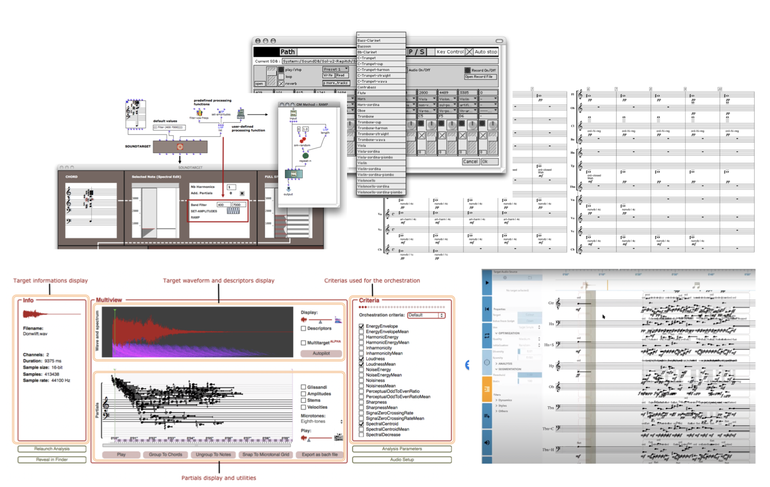Orchid*
Le logiciel d’aide à l’orchestration de l’Ircam, conçu et développé au sein de l’équipe RepMus, compose des mixtures instrumentales comme solution d’un problème d’orchestration consistant à imiter perceptivement une cible acoustique. Orchid* est le résultat de 15 années de recherches sur l'orchestration computationnelle menées au sein de l'équipe et constitue aujourd'hui un ensemble de recherche et de développements unique au monde dans le domaine de l'orchestration avec 3 thèses de doctorat, des dizaines d'articles et plusieurs logiciels informatiques qui ont été largement utilisé pour la composition d'œuvres importantes du répertoire contemporain.
Les concepts fondamentaux qui ont débouché sur Orchid* ont été débattus au sein du groupe de recherche "Orchestration" de l'Ircam, regroupant de nombreux chercheurs (Gérard Assayag, Xavier Rodet, Geoffroy Peeters...) et compositeurs (Yan Maresz, Fabien Lévy, Joshua Fineberg, Tristan Murail, Mauro Lanza, ...) dès 2004. Yan Maresz est à l’origine de l’idée principale derrière Orchid* et il a par la suite été le conseiller musical tout au long du développement du logiciel. Comme il l’exprime alors : "Le travail de ce groupe de recherche a abouti à un premier outil concret de recherche musicale dans le domaine de l'orchestration [...]. Il s'agit, de manière très schématique, de considérer le problème de manière "explorable" par le calcul grâce aux progrès effectués dans la description du son. [...] Il nous permettra aussi d'adresser le problème de l'orchestration du son électronique et celui de la "synthèse instrumentale" en se rapprochant d'un modèle acoustique donné, [...] par un rapprochement plus fin en considérant les instruments comme générateurs de sons complexes pouvant êtres mélangés pour obtenir une cible acoustique ou symbolique. " (Pour un traité d'orchestration au XXIe siècle, L'étincelle, Novembre 2006).
Dans cet esprit, Orchid* constitue un système complet pour l’orchestration assistée par ordinateur et l’optimisation de mélanges de timbres. Il fournit un ensemble d’algorithmes permettant de reconstruire n’importe quelle cible sonore évoluant dans le temps par une combinaison d’instruments ou échantillons, selon un ensemble de critères acoustiques et perceptifs. Il peut aider les compositeurs à obtenir des couleurs de timbre inouïes en fournissant une multitude de solutions efficaces qui recréent au mieux cette cible sonore. Grâce à un ensemble étendu de fonctionnalités, Orchid* peut également reproduire des évolutions timbrales et orchestrales en analysant la dynamique temporelle selon diverses stratégies. Ses résultats fournissent des partitions d’orchestre multiples pouvant être organisées de manière intuitive afin d’obtenir rapidement une réalisation d’idées orchestrales et musicales. Orchid* peut utiliser plusieurs bases de données de sons instrumentaux mais peut également être étendu de manière illimitée, y compris avec des sons de synthèse, en important simplement sa propre banque de sons.
Une bibliographie complète des travaux autour d'Orchid* se trouve ici.
Orchid* s’est décliné en trois instances logicielles successives développées au sein de l’équipe, qui mettaient chacune en avant des aspects spécifiques tout en tentant d'améliorer en permanence la qualité musicale par le choix d'heuristiques et la qualité de l'expérimentation musicale.
- Orchidée, la première réalisation a fixé les lois du genre en termes de fonctionnalités et de méthodes : orchestration imitative, prédiction de descripteurs audio des mixtures, optimisation multi ou mono objectif par algorithme génétique pour la recherche des solutions orchestrales, orchestration statique (cible unique) ou séquentielle (par segmentation / enchaînement), mixture de partiels, filtrages parcontraintes, etc. Orchidée se déclinait aussi bien en standalone que toolbox d’interface Max (Orchis) ou OpenMusic dialoguant avec le moteur d’orchestration.
- Orchids, la deuxième réalisation, a étendu le champ d’orchidée, en passant de l’optimisation multi-objectif dans un espace de descripteurs à l’optimisation de séries temporelles sur ces descripteurs, ouvrant la voie à l’orchestration dynamique continue de morphologies spectrales complexes et évolutives. Orchids propose une riche interface standalone.
- Orchidea, la version la plus récente, se base comme les autres sur la recherche génétique pour l’optimisation mono ou multi-objectif et la prédiction de descripteurs, avec une version standalone ou un client Max. Orchidea affine et optimise encore l’analyse et la prédiction de descripteurs, la recherche génétique de solutions et la qualité des enchaînements séquentiels, propose des heuristiques musicales largement testées et fluidifie l’interface utilisateur.
Orchidée a été écrit par Grégoire Carpentier qui a consacré sa thèse de doctorat à cet environnement en collaboration avec la thèse de Damien Tardieu dans l’équipe Analyse – Synthèse qui a fixé la prédiction de descripteurs.
Orchids a été écrit par Philippe Esling, qui a consacré une partie de sa thèse de doctorat à cet environnement, et Antoine Bouchereau qui l’a finalisé dans le cadre d’un contrat R&D de l’Ircam.
Orchidea a été écrit par Carmine Emanuele Cella au sein de l'équipe Représentations Musicales de l'Ircam dans le cadre de contrats de R&D co-financés par l’Ircam et la Haute Ecole de Musique de Genève (HEM), une collaboration mise en place par le regretté Eric Daubresse pour aborder la troisième génération Orchid*. Carmine Cella continue aujourd'hui de participer au projet à l' Université de Berkeley où il est Professeur, ainsi que des intervenants indépendants comme Daniele Ghisi.
Du point de vue institutionnel, les droits (copyright) se répartissent entre l’Ircam (qui apporte l'ensemble de la connaissance antérieure de la ligne Orchid*) et, pour Orchidea, la HEM. Orchidée et Orchids ne sont plus maintenus.
Il est prévu que la suite de l'évolution d'Orchid* se place dans le cadre d’une collaboration de l'Ircam, et de l'Université de Berkeley, ainsi que d’acteurs indépendants (Daniele Ghisi) qui ont participé aux derniers releases d'Orchidea, de sorte que le logiciel, qui suscite l’intérêt et l’engagement de plusieurs acteurs institutionnels et compositeurs renommés, puisse continuer d’évoluer dans les meilleures conditions. Pour cela, nous prévoyons dans un avenir prochain, de relâcher le code d’Orchid* en OpenSource de sorte que toutes les personnes interessées puissent continuer d'y collaborer et de profiter librement de leurs contributions et créations .
